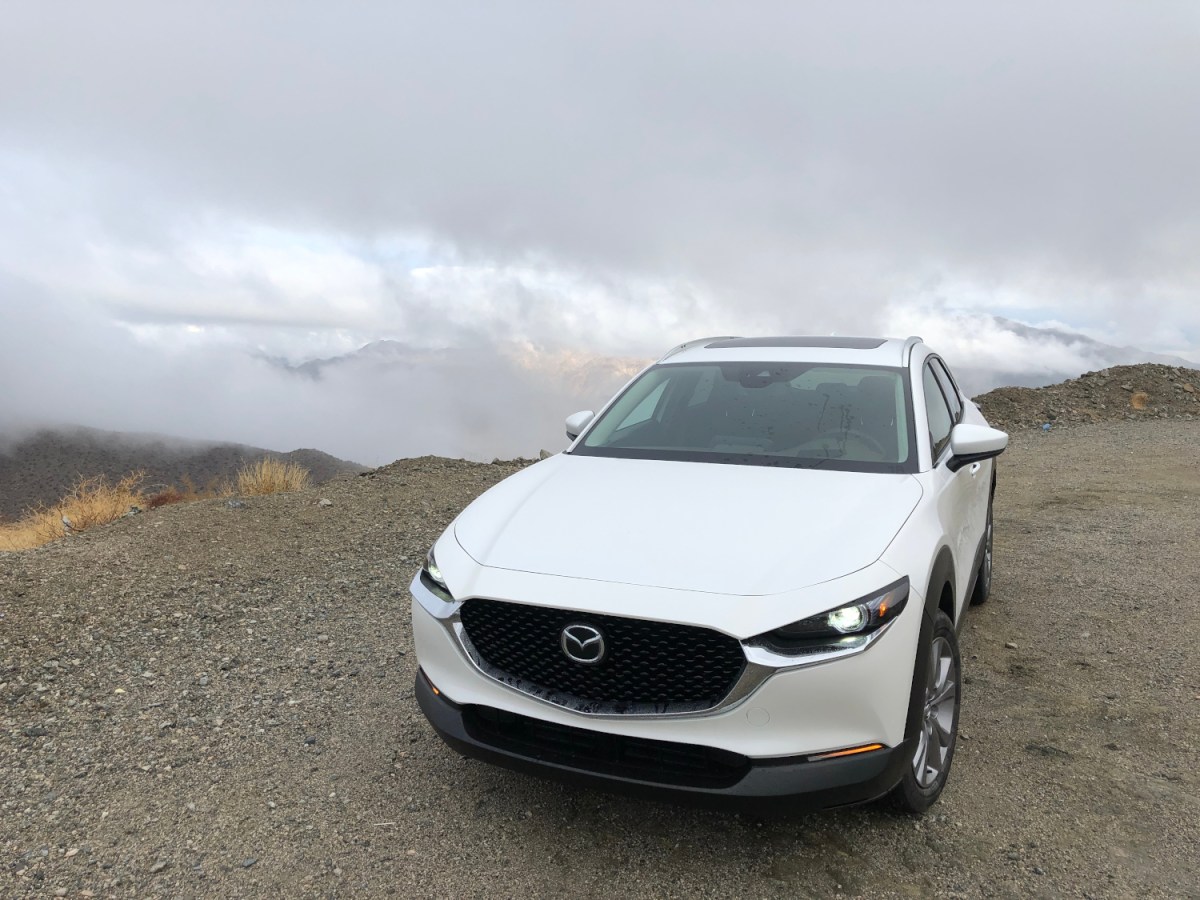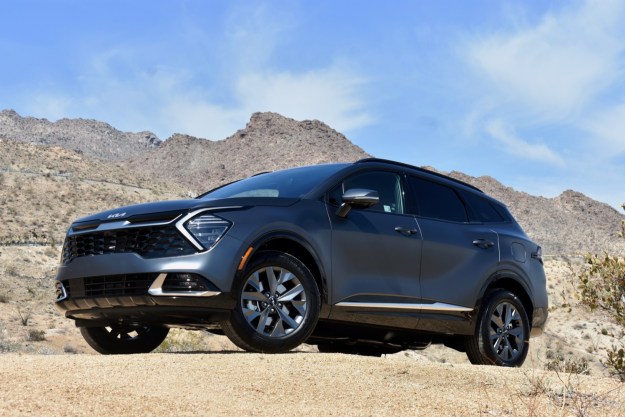
“Mazda is bringing the right small SUV at the right time.”
- Spectacular looks
- Solid performance
- Whisper-quiet cabin
- Sports car handling
- Ample interior room
- Infotainment is hard to use
- Performance model missing from trim walk
The 2020 Mazda CX-30 is a completely new small crossover SUV, designed to hit the sweet spot between the often-cramped subcompact crossovers (including Mazda’s own CX-3) and the larger compact class, where vehicles have grown along with their popularity. Mazda hope the CX-30 is a “right-sized” SUV for singles, couples, and families with small children.
Mazda also aims for a more premium feel than the economy class competition, and a much better value than comparable premium SUVs. The 2020 Mazda CX-30 starts at $21,900, with a $1,045 destination and shipping fee – that’s $22,945 out the door for the base model. If you go all-in with the top trim, all-wheel-drive, and the Soul Red Crystal paint that mesmerizes your eyes, you can expect to spend $31,240. But what you get for those prices is much more than competitors are offering.
What you get with the CX-30
The CX-30 is based on the same platform as last year’s new Mazda3 sedan and hatchback, and benefits from improvements that made that car one of our favorites of 2018. Mazda is known as a driver’s brand, and the CX-30 lives up to that reputation.
Subcompact SUVs are almost always underpowered and cramped, while so-called compact SUVs have become bloated and expensive. Mazda wisely gave the CX-30 its well-proven SKYACTIV-G 2.5-liter engine rated at 186 horsepower and 186 pound-feet of torque.
That’s better than the Hyundai Kona, which delivers 147 horsepower in the base model, or 175 in the upgraded turbo trims. The still-fresh Nissan Kicks comes in at 122 horsepower, and the Ford EcoSport ranges from 123 in the base trim to 166 horsepower in the top trims. Clearly, Mazda is on another level when it comes to hustle, and you’ll feel that while merging into traffic.
Mazda also went for a real six-speed automatic transmission, eschewing the performance-sucking continuously variable units found in other economy brands. Front-wheel-drive is standard, but Mazda’s i-ACTIV all-wheel-drive system is available for a $1,400 premium on all trims.
It all adds up to a vehicle that feels light on its feet. The CX-30 can easily get out of its own way, and that immediately gives it an advantage over most small SUVs.
Built for the road
As a driver’s brand, Mazda has developed a few key technologies that improve the driving experience. The optional i-ACTIV all-wheel-drive system is as good as any from a premium brand, using real-time data to predict wheel slip before it occurs and deliver smooth traction at all times.
Mazda also has the industry-exclusive G Vectoring Control Plus, which adjusts engine torque to shift weight forward and increase steering response in cornering, and then applies a slight brake drag on exit to give you razor-sharp cornering. That’s all on top of a suspension designed by the same people who created the Miata.

The CX-30 rides through deep puddles without a jostle and sticks to the pavement on tight corners. Put it all together and you get a ride and handling package that compares favorably to more expensive options such as the Audi Q3.
No, you probably won’t spend a lot of time hustling the CX-30 through corners at high speeds. But its performance has another purpose. Confidence. The CX-30 always feels planted, smooth, and capable.
Spacious and quiet interior
Mazda worked some magic there to give the front-seat passengers plenty of room to stretch out. We drove the CX-30 all day with two, shall we say, ‘full-sized’ American men, and not once did we bump elbows. Headroom, shoulder, hip room, and leg room were all designed for comfort.
Mazda’s seats also deserve a shout-out. The premium trim passenger seat offers good support and comfort, with seat heat that’s good enough to toast your buns in any winter weather. The driver’s seat is even better, as it can add adjustable lumbar support.

Despite its airy interior, this is still a small compact crossover, so there’s no real Tardis magic going on. The rear seats can handle adults, but not without pushing the front seats forward. Standard cargo space is 20.2 cubic feet, which is plenty for two but (at most) adequate for four people making a run to the airport with luggage.
To match it up against market leaders, the popular Buick Encore comes in at 18.8 cubes, while the Honda HR-V leads the CX-30 with 23.2 cubic feet. Even the larger Nissan Rogue Sport clocks in with 19.9 to 22.9 cubic feet, depending on the trim level. The CX-30 is mid-pack in overall volume, which might be a problem if you make frequent trips to Ikea. That said, it’s far more functional than a compact sedan.
For the front-seat passengers, at least, the CX-30 is a great place to spend time. Its quiet interior makes sure of that. Mazda’s engineers have worked hard to keep noise out regardless of the road surface. One factor is speaker placement. As on the Mazda3, the low-end speakers have been moved out of the doors and into the footwells to eliminate what was a big hole in the side of the car, and it really makes a difference. You’ll appreciate the 12-speaker Bose audio system all the more for it.
We get the logic for the infotainment, but…
Mazda is always thinking about safety and ergonomics. That’s why they gave the CX-30 an available head-up display; to keep the driver’s eyes on the road. Yet the HUD is less of a differentiator now than it was when Mazda first introduced it.
The Hyundai Kona and Kia Niro both offer a HUD, while you must go up one size to get it from Toyota. You can find a HUD in the RAV4, but not the subcompact C-HR. It’s the same story with Honda. It’s in the compact CR-V, but not the subcompact HR-V.
For the same ergonomic reasons, Mazda moved the standard 8.8-inch infotainment screen up to the dash. However, you can’t have a touchscreen up there (it would be out of reach), so all the controls are either on the steering wheel or available through a rotary-click dial down on the console.

This system is a compromise. Information is visible but can be less than intuitive to navigate. If you own the CX-30 (or any Mazda) you’ll eventually learn it, of course, but it may still trip you up from time to time. This may prove to be one of the Mazda CX-30’s definitive features. While many people want a touchscreen, others strongly dislike them. You’ll like the CX-30’s controls if you’re in the latter group.
To be fair, no automaker has nailed the user interface for a modern infotainment system. There’s too much content to put a button on the dash for everything, and voice control will only get you so far.
Right-sized, right-priced
The CX-30 delivered precisely what we expect from Mazda: a delightful driving experience with plenty of sporty performance and one-class-up comfort and amenities. As a bonus, Mazda has made adaptive cruise control and LED headlights standard on all trims. You don’t have to spend a penny over the base model to get those features.
If you cross-shop, the CX-30 occupies the same price range as the Hyundai Kona, Subaru Crosstrek, or the Honda HR-V, but gives you more features for the money. The real comparison is to the premium European and Asian brands, and that’s where you’ll find the CX-30 combines the features and comfort you want at a price that undercuts the premium brands by many thousands of dollars.
How DT would configure this car
With the fairly tight price range on the CX-30 and the available features, we’d suggest going all-in on the top trim. You can get a regular color if you want to blend, but where’s the fun in that? It’s said that if you don’t look back at your car when you walk away from it, you bought the wrong car. We’d like to see that hypnotic Soul Red Crystal every time we park.
On top of that, we like the leather, heated seats, navigation, and all the rest. The top trim CX-30 still comes in several thousand less than the base price of the Audi, and we think that makes this choice a no-brainer.
Should you get one?
Yes. This is a great SUV for the money. It’s right-sized for singles, couples, empty-nesters, and even for families with small children.
Editors' Recommendations
- Mercedes-AMG EQE SUV first drive review: a better electric SUV
- Mercedes-Benz EQE SUV first drive review: ’90s look, cutting-edge tech
- Kia EV6 GT first-drive review: putting a little more fun into EVs
- 2022 Volkswagen ID. Buzz first drive review: The iconic hippie hauler goes electric
- 2022 Mercedes-Benz EQB first drive review: An EV better than its gas sibling


